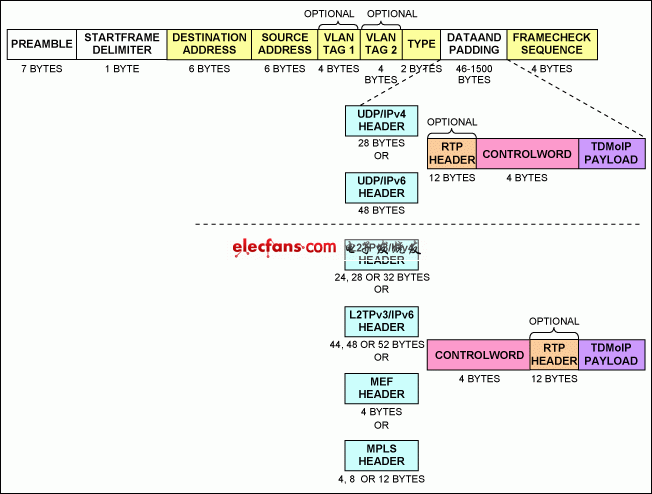Abstract: Interoperability is the ability of a system to work with other systems with little or no system operator intervention. The interoperability of the system makes it possible to serve other systems or accept services from other systems, enabling systems from different vendors to work together. This application note describes how to set up the DS34S132 TDM-over-Packet (TDMoP) IC to interoperate with other TDMoP devices.
introduction
Needless to say, today's communication systems require complex interactions between different devices and devices. As technology advances, interoperability becomes more important. Interoperability is the ability of a system to work with other systems with little or no system operator intervention. The interoperability of the system makes it possible to serve other systems or accept services from other systems, enabling systems from different vendors to work together.
This application note focuses on the Maxim TDM-over-Packet (TDMoP) IC, DS34S132. The article describes the setup requirements for interoperability between the DS34S132 and other vendors' TDMoP devices.
Interoperability requirements
The data packets generated by Maxim's TDMoP devices may differ from the header information of other manufacturers' TDMoP devices. In order for the TDMoP device to interoperate, the user needs to know the type of device setup. The Maxim device is set to one of the following:
IP/UDP/RTP/SAToP
IP/UDP/RTP/CESoPSN
MEF/RTP/CESoETH—unstructured (ie MEF/SAToP)
MEF/RTP/CESoETH—Structured Lock (ie MEF/CESoPSN)
MPLS/RTP/SAToP—unstructured (ie MPLS/RTP/SAToP)
MPLS/RTP/CESoPSN—Structured Lockdown (ie MPLS/RTP/CESoPSN)
Each TDMoP device setup has a different header. For interoperability, the headers from the Maxim TDMoP device must be formatted to be the same as the headers of other devices. This means that users need to compare the headers of TDMoP devices and look for format differences. This application note describes how to modify the header of the DS34S132 TDMoP device using Maxim's application. The article also describes how to modify the Maxim binding configuration to accept packets with the same protocol but different header information.
TDMoP format
This section describes the functional description of the TDM-over-Packet module. To transmit TDM data over a packet-switched network, the TDMoP device encapsulates the TDM data as an Ethernet packet, as shown in Figure 1. See Table 1 for a description of the different data blocks in the TDMoP header.

Figure 1. TDMoP package for Ethernet packet format.
Table 1. Ethernet packet domain description
The leading 56-bit sequence (alternating 1 and 0 values) is used for synchronization. Provides the time at which the heartbeat appears for devices on the network.
The start frame delimiter 8-bit sequence (10101011) indicates the start of the packet.
Target and Source Address The target address field indicates the terminal that receives the data. The source address indicates the terminal that sent the packet. The target address can be a "single address" that specifies the target as a single terminal, or a "multicast address" that targets a group of workstations. A destination address with all bits of 1 indicates all terminals on the LAN and is referred to as a "broadcast address." "
Type Ethernet type
Data and Filler This field contains data that is transmitted from the source terminal to the target terminal. The maximum size of this field is 1500 bytes. The minimum Ethernet packet size from the destination address field to the frame check sequence is 64 bytes. If the packet size of the domain is less than 64 bytes, the padding is used to minimize the packet size.
Frame Check Sequence This field includes a 4-byte Cyclic Redundancy Check (CRC) value for error checking. When the source terminal encapsulates the data packet, the CRC calculation is performed on all bits in the data packet from the target address to the filler field (that is, all fields except the preamble, the start frame delimiter, and the frame check sequence). The source terminal saves the calculated value in the domain and sends it as part of the packet. When the target terminal receives the data packet, it performs the exact same check. If the calculated value does not match the value in the field, the target terminal considers that an error occurred during the transmission and discards the packet.
In order to achieve interoperability, users need to pay attention to the two parts of the TDMoP header:
UDP/IPv4 header interoperability
RTP header interoperability
UDP/IPv4 header interoperability
Figure 2 shows the UDP/IPv4 header structure. Tables 2 and 3 detail the different domains of the IPv4 and UDP header structures.

Figure 2. UDP/IPv4 header.
SHENZHEN YINZHIGUAN DIGITAL TECHNOLOGY CO.,LTD , http://www.yzgmusiccrown.com